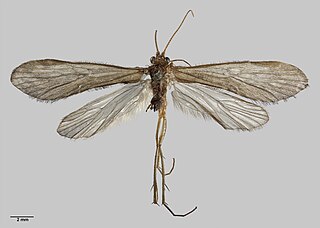Alloecentrella is a genus of caddisflies belonging to the order Trichoptera. The genus was first recognised by Keith Arthur John Wise in 1958.
Alloecentrella magnicornis is a species of caddisfly belonging to the order Trichoptera. The species was first described by Keith Arthur John Wise in 1958, and is endemic to New Zealand.

Diplectrona bulla is a species of caddisfly belonging to the order Hydropsychidae. The species was first described by Keith Arthur John Wise in 1958, and is endemic to New Zealand.

Ecnomina zealandica is a species of caddisfly belonging to the family Ecnomidae. The species was first described by Keith Arthur John Wise in 1958, and is endemic to New Zealand.

Hydrobiosis falcis is a species of caddisfly belonging to the family Hydrobiosidae. The species was first described by Keith Arthur John Wise in 1958, and is endemic to New Zealand.

Neobiosella is a monotypic genus of caddisfly belonging to the family Philopotamidae. The sole species found in this genus is Neobiosella irrorata. Both the genus and species were first described by Keith Arthur John Wise in 1958. Neobiosella is endemic to New Zealand.

Oeconesus is a genus of caddisflies belonging to the family Oeconesidae. The genus was first recognised by Robert McLachlan in 1862. All known species of Oeconesus are endemic to New Zealand.

Oeconesus lobatus is a species of caddisfly belonging to the family Hydrobiosidae. The species was first described by Keith Arthur John Wise in 1958, and is endemic to New Zealand.

Pseudoeconesus bistirpis is a species of caddisfly belonging to the family Hydrobiosidae. The species was first described by Keith Arthur John Wise in 1958, and is endemic to New Zealand.

Pycnocentrodes is a genus of caddisflies belonging to the family Conoesucidae. The genus was first recognised by Robert John Tillyard in 1924. All known species of Pycnocentrodes are endemic to New Zealand.

Olinga is a genus of caddisflies belonging to the family Oeconesidae. The genus was described by Robert McLachlan in 1868, revising the genus name in 1894. All known species of Olinga are endemic to New Zealand.

Olinga fumosa is a species of caddisfly belonging to the family Conoesucidae. The species was first described by Keith Arthur John Wise in 1958, and is endemic to New Zealand.
Confluens is a genus of caddisflies belonging to the family Oeconesidae. The genus was described by Keith Arthur John Wise in 1962, after noticing differences in two species previously placed within the genus Pycnocentrodes. Both species of Confluens are endemic to New Zealand.
Polyplectropus impluvii is a species of caddisfly belonging to the family Polycentropodidae. The species was first described by Keith Arthur John Wise in 1962, and is endemic to New Zealand.
Polyplectropus waitakerensis is a species of caddisfly belonging to the family Polycentropodidae. The species was first described by Keith Arthur John Wise in 1962, and is endemic to New Zealand.
Orthopsyche thomasi is a species of caddisfly belonging to the family Hydropsychidae. The species was first described by Keith Arthur John Wise in 1962, and is endemic to New Zealand.

Costachorema notopterum is a species of caddisfly belonging to the family Hydrobiosidae. The species was first described by Keith Arthur John Wise in 1972, and is endemic to the Auckland Islands of New Zealand.
Tiphobiosis kuscheli is a species of caddisfly belonging to the family Hydrobiosidae. The species was first described by Keith Arthur John Wise in 1972, and is endemic to the Auckland Islands of New Zealand.

Edpercivalia harrisoni is a species of caddisfly belonging to the family Hydrobiosidae. The species was first described by Keith Arthur John Wise in 1982, and is endemic to New Zealand.

Oxyethira waipoua is a species of caddisfly belonging to the family Hydroptilidae. The species was first described by Keith Arthur John Wise in 1998, and is endemic to New Zealand.














